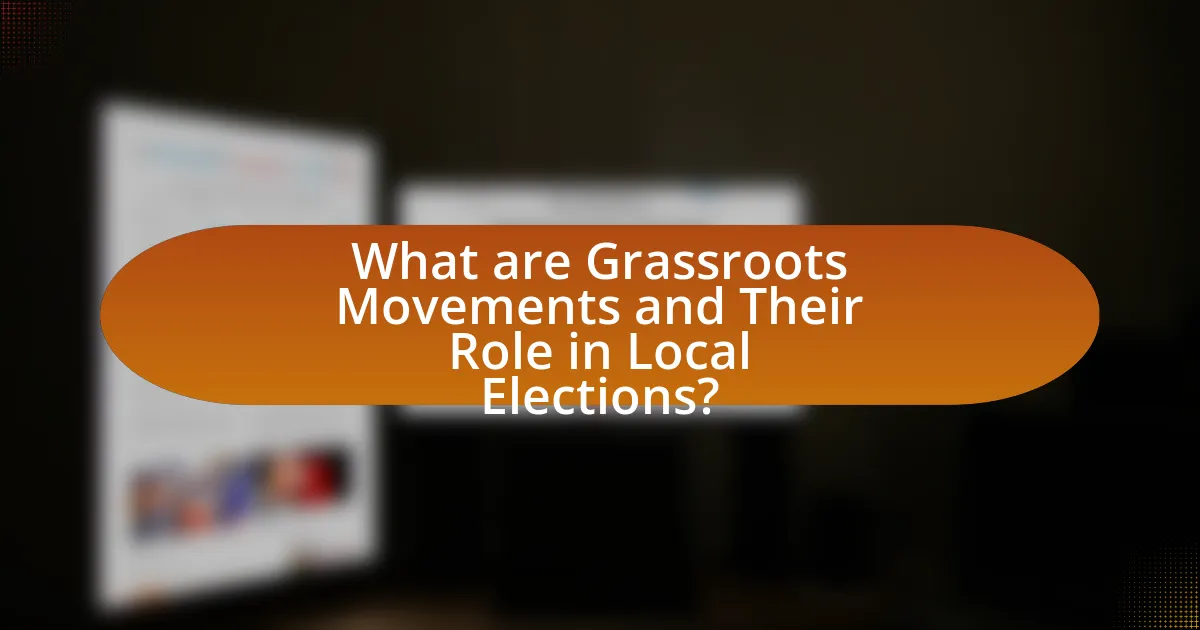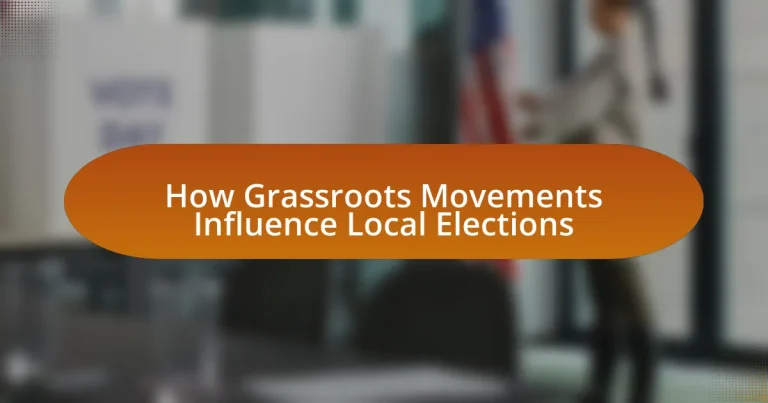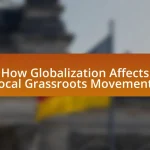Grassroots movements are organized efforts by ordinary individuals aimed at achieving social or political change at the local level, significantly impacting local elections. These movements mobilize voters, raise awareness about community issues, and influence candidate platforms, often increasing voter turnout by up to 20%. Unlike traditional political campaigns, grassroots initiatives rely on community engagement, small donations, and collective action, emphasizing inclusivity and representation of underrepresented voices. The article explores the characteristics, motivations, and strategies of grassroots movements, their effects on voter demographics, and the challenges they face, while highlighting best practices for enhancing their influence in local political contexts.

What are Grassroots Movements and Their Role in Local Elections?
Grassroots movements are organized efforts by ordinary people to effect social or political change at the local level, often driven by community issues and concerns. These movements play a crucial role in local elections by mobilizing voters, raising awareness about specific issues, and influencing candidate platforms. For instance, grassroots campaigns can significantly increase voter turnout; according to a study by the Pew Research Center, local grassroots efforts can boost participation rates by up to 20%. Additionally, grassroots movements often provide a platform for underrepresented voices, ensuring that local elections reflect the diverse needs of the community.
How do grassroots movements differ from traditional political campaigns?
Grassroots movements differ from traditional political campaigns primarily in their structure and funding sources. Grassroots movements are typically community-driven initiatives that rely on local volunteers and small donations, emphasizing collective action and engagement from the public. In contrast, traditional political campaigns often depend on larger financial contributions from wealthy donors and political action committees, focusing on organized, top-down strategies. For example, the 2016 Bernie Sanders campaign exemplified grassroots fundraising, raising over $230 million from small donations, while traditional campaigns like those of major party candidates often rely on substantial funding from corporate sponsors. This fundamental difference in approach influences how each type mobilizes support and engages with voters.
What are the key characteristics of grassroots movements?
Grassroots movements are characterized by their community-driven nature, emphasizing local participation and engagement. These movements typically arise from the collective efforts of individuals who share common interests or concerns, often mobilizing around social, political, or environmental issues. They rely on grassroots organizing strategies, such as door-to-door campaigning, community meetings, and social media outreach, to build support and raise awareness. Additionally, grassroots movements often prioritize inclusivity and diversity, ensuring that marginalized voices are heard and represented. Evidence of their impact can be seen in various local elections, where grassroots campaigns have successfully challenged established political structures, demonstrating the power of community mobilization in influencing electoral outcomes.
Why are grassroots movements important in local political contexts?
Grassroots movements are important in local political contexts because they empower community members to engage in the political process and advocate for their interests. These movements often arise from local issues, allowing residents to mobilize around specific concerns such as education, housing, or public safety. For instance, the 2011 Occupy Wall Street movement highlighted economic inequality, influencing local policies and elections across the United States. Grassroots movements can also increase voter turnout by fostering a sense of community and shared purpose, as evidenced by the success of local initiatives that have led to higher participation rates in elections.
What motivates individuals to participate in grassroots movements?
Individuals are motivated to participate in grassroots movements primarily by a desire for social change and community empowerment. This motivation often stems from personal experiences of injustice or inequality, prompting individuals to seek collective action to address these issues. Research indicates that emotional connections to specific causes, such as environmental protection or social justice, significantly drive participation. For instance, a study by the Pew Research Center found that 70% of participants in grassroots movements cited a personal connection to the cause as a key motivator. Additionally, the sense of belonging and community that grassroots movements foster encourages individuals to engage actively, reinforcing their commitment to the movement’s goals.
How do personal experiences influence participation in grassroots movements?
Personal experiences significantly influence participation in grassroots movements by shaping individuals’ motivations and perspectives on social issues. For instance, individuals who have faced discrimination or injustice are more likely to engage in movements that address those specific grievances, as evidenced by studies showing that personal encounters with inequality often lead to increased activism. Research conducted by the Pew Research Center indicates that 70% of participants in social movements cite personal experiences as a primary motivator for their involvement. This connection between personal narrative and collective action underscores how individual histories can galvanize community engagement and drive grassroots initiatives aimed at effecting change in local elections.
What role does community engagement play in motivating grassroots activism?
Community engagement is crucial in motivating grassroots activism as it fosters a sense of belonging and collective purpose among individuals. When community members actively participate in discussions, events, and initiatives, they develop stronger connections to the issues at hand, which enhances their commitment to activism. Research indicates that communities with high levels of engagement see increased participation in local elections, as individuals feel empowered to influence change. For instance, a study by the National Civic League found that engaged communities are 50% more likely to mobilize voters compared to less engaged ones, demonstrating the direct correlation between community involvement and grassroots activism.
How do grassroots movements impact voter turnout in local elections?
Grassroots movements significantly increase voter turnout in local elections by mobilizing community engagement and fostering a sense of civic responsibility. These movements often utilize door-to-door canvassing, social media campaigns, and local events to raise awareness about the importance of voting, which directly influences participation rates. For instance, a study by the Harvard Kennedy School found that grassroots efforts can increase voter turnout by as much as 10% in local elections, demonstrating their effectiveness in energizing the electorate.
What strategies do grassroots movements use to mobilize voters?
Grassroots movements mobilize voters through community engagement, targeted outreach, and leveraging social media. Community engagement involves organizing local events, door-to-door canvassing, and town hall meetings to foster personal connections and inform voters about issues. Targeted outreach focuses on identifying and reaching specific demographics, often utilizing data analytics to tailor messages that resonate with particular groups. Social media platforms are employed to amplify messages, organize campaigns, and create viral content that encourages voter participation. For instance, the 2018 midterm elections saw grassroots organizations like Indivisible effectively use social media to mobilize millions of voters, demonstrating the power of these strategies in influencing local elections.
How does grassroots activism affect the demographics of voters in local elections?
Grassroots activism significantly influences the demographics of voters in local elections by mobilizing underrepresented groups and increasing voter participation. This type of activism often focuses on issues that resonate with specific communities, such as social justice, environmental concerns, or economic inequality, thereby engaging individuals who may have previously felt disenfranchised. For instance, studies have shown that grassroots campaigns can lead to higher turnout rates among young voters and minority populations, as seen in the 2018 midterm elections where organizations like NextGen America mobilized young voters, resulting in a 50% increase in turnout among this demographic compared to previous elections. This engagement not only alters the composition of the electorate but also encourages candidates to address the needs and concerns of these newly active voter groups, further shaping local political landscapes.
What challenges do grassroots movements face in influencing local elections?
Grassroots movements face significant challenges in influencing local elections, primarily due to limited funding and resources. These movements often rely on small donations and volunteer efforts, which can restrict their ability to compete against well-funded candidates or established political parties. For instance, a study by the National Institute for Money in Politics found that candidates with substantial financial backing are more likely to win elections, highlighting the disparity in resources. Additionally, grassroots movements may struggle with voter engagement and mobilization, as they often lack the infrastructure and outreach capabilities of larger organizations. This can result in lower voter turnout among their supporters, further diminishing their impact on election outcomes.
How do funding and resources impact the effectiveness of grassroots movements?
Funding and resources significantly enhance the effectiveness of grassroots movements by providing essential support for outreach, organization, and mobilization efforts. For instance, financial backing allows these movements to hire staff, develop marketing materials, and conduct events that raise awareness and engage the community. A study by the Stanford Social Innovation Review found that grassroots organizations with adequate funding are 50% more likely to achieve their goals compared to those with limited resources. Additionally, access to resources enables movements to leverage technology for communication and coordination, further amplifying their impact in local elections.
What legal and political obstacles do grassroots movements encounter?
Grassroots movements encounter significant legal and political obstacles, including restrictive campaign finance laws and regulatory barriers. These movements often struggle with limited access to funding due to regulations that favor established political entities, making it difficult to compete effectively. Additionally, grassroots organizations may face challenges in obtaining necessary permits for public demonstrations or events, which can hinder their visibility and outreach efforts. For instance, laws that impose strict requirements on petitioning or organizing can disproportionately affect smaller movements, as seen in various states where signature-gathering processes are complicated by legal stipulations. Furthermore, political opposition from established parties can lead to hostile environments, including attempts to delegitimize grassroots efforts through misinformation or legal challenges. These factors collectively impede the ability of grassroots movements to mobilize support and influence local elections effectively.
How can grassroots movements effectively collaborate with local communities?
Grassroots movements can effectively collaborate with local communities by fostering inclusive dialogue and building trust through consistent engagement. This collaboration involves actively listening to community needs, organizing local forums, and creating partnerships with existing community organizations. For instance, research shows that grassroots initiatives that prioritize community input, such as the “Community Organizing for Social Change” model, lead to higher participation rates in local elections and civic activities. By aligning their goals with the interests of the community, grassroots movements can mobilize support and drive collective action, ultimately influencing local electoral outcomes.
What are the best practices for grassroots movements to enhance their influence?
Grassroots movements can enhance their influence by building strong community networks, utilizing social media effectively, and engaging in strategic partnerships. Strong community networks foster trust and mobilize local support, as evidenced by the success of movements like Black Lives Matter, which leveraged community organizing to amplify their message. Effective use of social media allows grassroots movements to reach wider audiences quickly; for instance, the Ice Bucket Challenge raised over $220 million for ALS research through viral social media engagement. Strategic partnerships with established organizations can provide resources and credibility, as seen in the collaboration between environmental groups and local governments to promote sustainability initiatives. These practices collectively strengthen grassroots movements’ ability to impact local elections and policy decisions.
How can grassroots movements leverage social media for local election campaigns?
Grassroots movements can leverage social media for local election campaigns by utilizing targeted messaging, community engagement, and mobilization strategies. Social media platforms allow these movements to reach specific demographics effectively, enabling them to tailor their messages to resonate with local voters. For instance, according to a study by the Pew Research Center, 69% of adults in the U.S. use social media, making it a vital tool for outreach. Additionally, grassroots movements can create viral content that encourages sharing, thereby amplifying their reach and influence. Engaging with followers through live Q&A sessions, polls, and community discussions fosters a sense of belonging and encourages voter participation. Furthermore, data analytics can help these movements track engagement and adjust their strategies in real-time, ensuring they remain relevant and impactful throughout the campaign.
What role does coalition-building play in strengthening grassroots movements?
Coalition-building plays a crucial role in strengthening grassroots movements by enhancing their collective power and reach. When diverse groups unite under a common cause, they can pool resources, share knowledge, and amplify their voices, which increases their influence in local elections. For instance, the coalition of various community organizations during the Fight for $15 campaign successfully advocated for minimum wage increases in multiple cities, demonstrating how collaboration can lead to tangible policy changes. This collective action not only mobilizes more supporters but also creates a broader platform for addressing systemic issues, thereby reinforcing the grassroots movement’s effectiveness in shaping local electoral outcomes.
What lessons can be learned from successful grassroots movements in local elections?
Successful grassroots movements in local elections demonstrate the importance of community engagement and mobilization. These movements often succeed by building strong networks of volunteers who are passionate about local issues, which enhances voter turnout and awareness. For instance, the 2018 midterm elections in the United States saw a significant increase in voter participation, largely attributed to grassroots efforts that focused on local concerns such as healthcare and education. Additionally, successful movements utilize social media effectively to spread their message and organize events, as seen in the campaigns of various local candidates who leveraged platforms like Facebook and Twitter to connect with constituents. These examples illustrate that grassroots movements can significantly influence local elections by fostering community involvement, utilizing digital tools for outreach, and focusing on relevant local issues.


